Hard Asset Digest January 2020

Hard Asset Digest
January 2020
In this month’s issue, I’m bringing you my exclusive interview with Mr. Mickey Fulp — founder and editor of the Mercenary Geologist.
A professional geologist by trade, Mickey boasts 40-plus years of experience as an exploration geologist and analyst searching for economic deposits of base and precious metals, industrial minerals, coal, uranium, and oil & gas in North and South America, Europe, and Asia.
Mickey holds a B.Sc. Earth Sciences with honors from the University of Tulsa and an M.Sc. Geology from the University of New Mexico and is a Certified Professional Geologist.

Mickey Fulp, Founder & Editor
Mercenary Geologist
A regular speaker at the most prestigious North American mining conferences, Mickey has literally done it all in the mining space, having worked with numerous junior exploration companies, major mining firms, private companies, and investors as a consulting economic geologist specializing in geological mapping, property evaluation, and business development.
From 2003 to 2006, his geological mapping on behalf of junior explorers resulted in outcropping gold and copper discoveries in Peru, Nevada, Chile, and British Columbia.
His expertise in field geology and analytics led him to launch his free web-based newsletter, Mercenary Geologist, in 2008, where he remains one of the most sought-after minds in the mining and exploration community for his ongoing work as an analyst, writer, and speaker.
In addition to his professional credentials and experience, Mickey is an admitted sports junkie (loves talking Blues hockey and Cardinals baseball), is high-altitude proficient, and is bilingual in English and Spanish.
He currently splits time between his farm in New Mexico and Vancouver, British Columbia.
With gold moving into what looks to be an extended bull market, I felt it was the perfect time to catch up with Mickey to see what he’s doing in the market.
We had a fascinating discussion, and I’m excited to be bringing it to you as we enter the new year!
But before we do that — let’s take a quick look at the yellow metal.
Gold is Breaking Out!
Gold closed out 2019 with an impressive rally – surging above $1,500 an ounce – and producing the sharpest annual return for the yellow metal in nearly a decade.
Gold is regarded as a safe-haven investment… a hedge, if you will, against rising geopolitical risk factors and the eroding purchasing power of the US dollar.
As you’re likely aware, debt loads in the United States – as well as every other developed nation – are now so immense that the debt service costs will remain unmanageable at any interest rate above the rate of inflation for the foreseeable future.
The end result: Gold and related speculations are poised to do very well as global economies race down this very precarious path of perpetual negative real rates and, likewise, as tensions ramp up across the Middle East, North Korea and elsewhere.
We’re seeing the predictable response to that very tumult now with gold continuing to ratchet higher in the new year. Gold closed at $1,546 an ounce at the time of this writing.
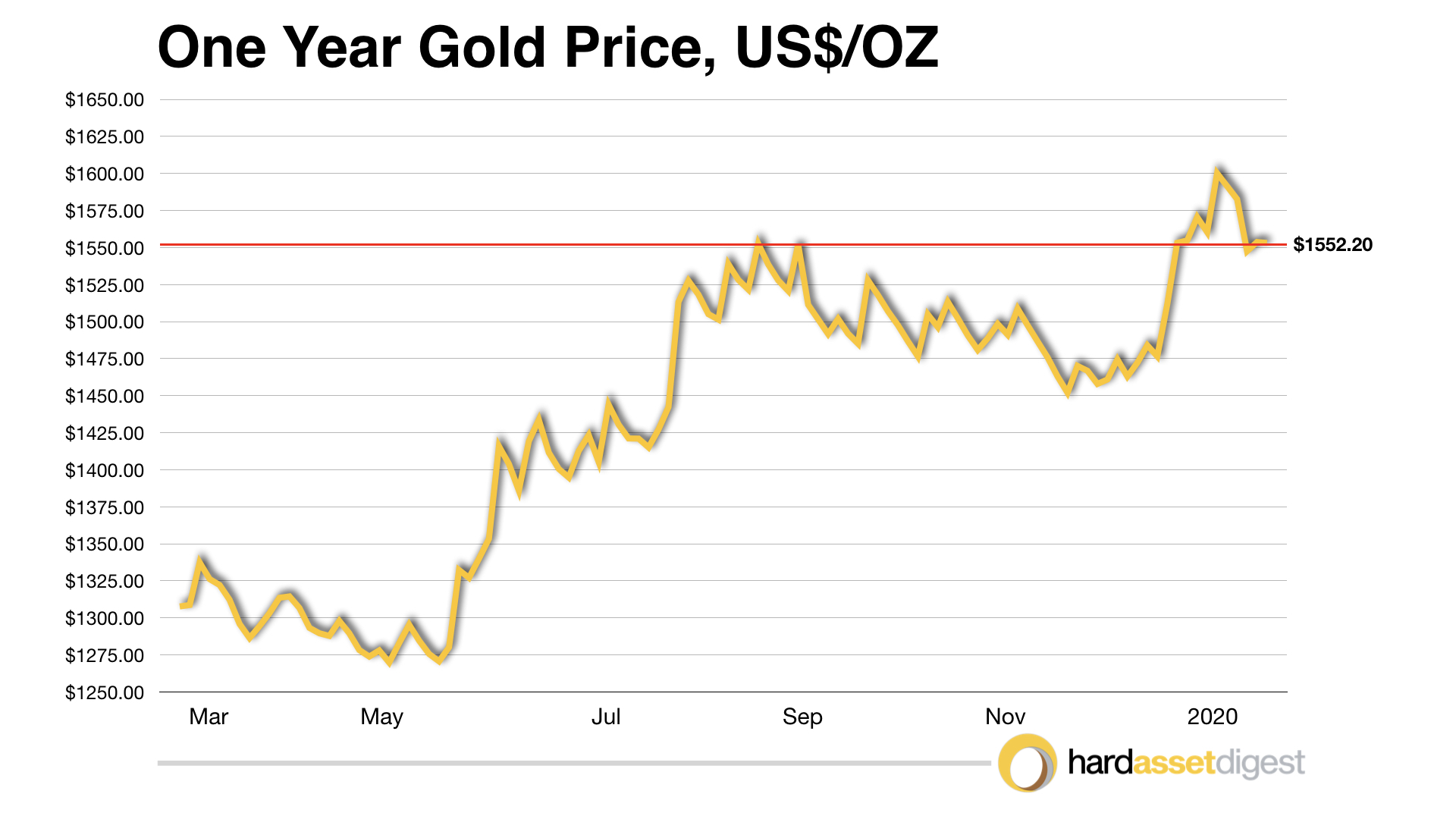
Further, with seasonal tax-loss selling now in the proverbial rearview, many junior gold companies are still trading at very opportune price levels.
Mickey Fulp, an avowed contrarian, is a steadfast proponent of buying gold juniors during tax loss season.
And although that window just ended in December, I asked Mickey what he’s doing now in the junior sector; his answers are coming right up!
Origins of Gold
When we ponder gold… it’s almost always from a “speculation,” “safe haven,” or “mining” perspective.
But what about gold’s cosmic origins… how often do we stop and think about the fact that ALL of the gold (“Au”) on earth – as well as ALL of the earth’s heaviest metals – were delivered to our planet during its formation?
In order to create heavy elements such as gold, you need temperatures that are extreme — we're talking millions of degrees. In general terms, the heavier the element, the hotter the temperature required to make it.
And where in the universe do we find such extreme temperatures? In our earth’s core? No... that only reaches about 6,000 degrees Celsius — a far cry from the millions of degrees required for gold creation.
We can look to a couple of scenarios where heavy metals creation is thought possible. One being the now universally accepted Big Bang model — occurring some 13.8 billion years ago and marking the beginning of the formation of our universe.
Another is in the core of neutron stars, which are formed at the end of supernova explosions.

Gold Creation: Binary Neutron Stars
Neutron stars have about 10x the mass of our sun and often come in pairs called binary stars. Now, you’re probably picturing a pair of very large suns… yet, that’s not the case.
Neutron stars are extraordinarily dense… picture a star that significantly outweighs our sun — yet is only about the size of the city of New York!
Scientists theorize that all of earth’s heavier elements were created during these powerful events — which produce fusion on an unimaginable scale.
Thus, a great number of the elements we cherish and/or rely upon such as gold, silver, nickel, copper, and uranium were in-the-mix so to speak and were dispersed across the cosmos during these game-changing events.
Naturally, comets and asteroids continued bombarding our planet for some 4.5 billion years as a sort of perpetual delivery service of these and other heavy elements.
When you look at the periodic table of elements, it’s no wonder that the largest group of elements are the metals. And, in that group is the metal we cherish most — GOLD!
Gold Never Rusts… Tarnishes… Or Weathers Away!
There’s nothing more beautiful than gold — nothing in the world. Its brilliant color captures the human eye like nothing else.
You just feel it when you see it.
Ancient civilizations placed a high value on the yellow metal before the concept of currency or money even existed. It's something people intrinsically knew had worth.
We feel that same intrinsic value today.
Scientifically speaking, gold has an extremely tightly-packed atomic structure as well as a strong positive charge. That means its outermost electrons are much less available for chemistry with other elements — making it the most non-reactive metal on earth.
Or put another way… gold is a native element that only combines with a few other metals to form alloys.
Hence... gold lasts forever!
That’s why we’re able to appreciate gold masterpieces from ancient artisans. These priceless art pieces are as beautiful today as they were thousands of years ago… and will be thousands of years from today.
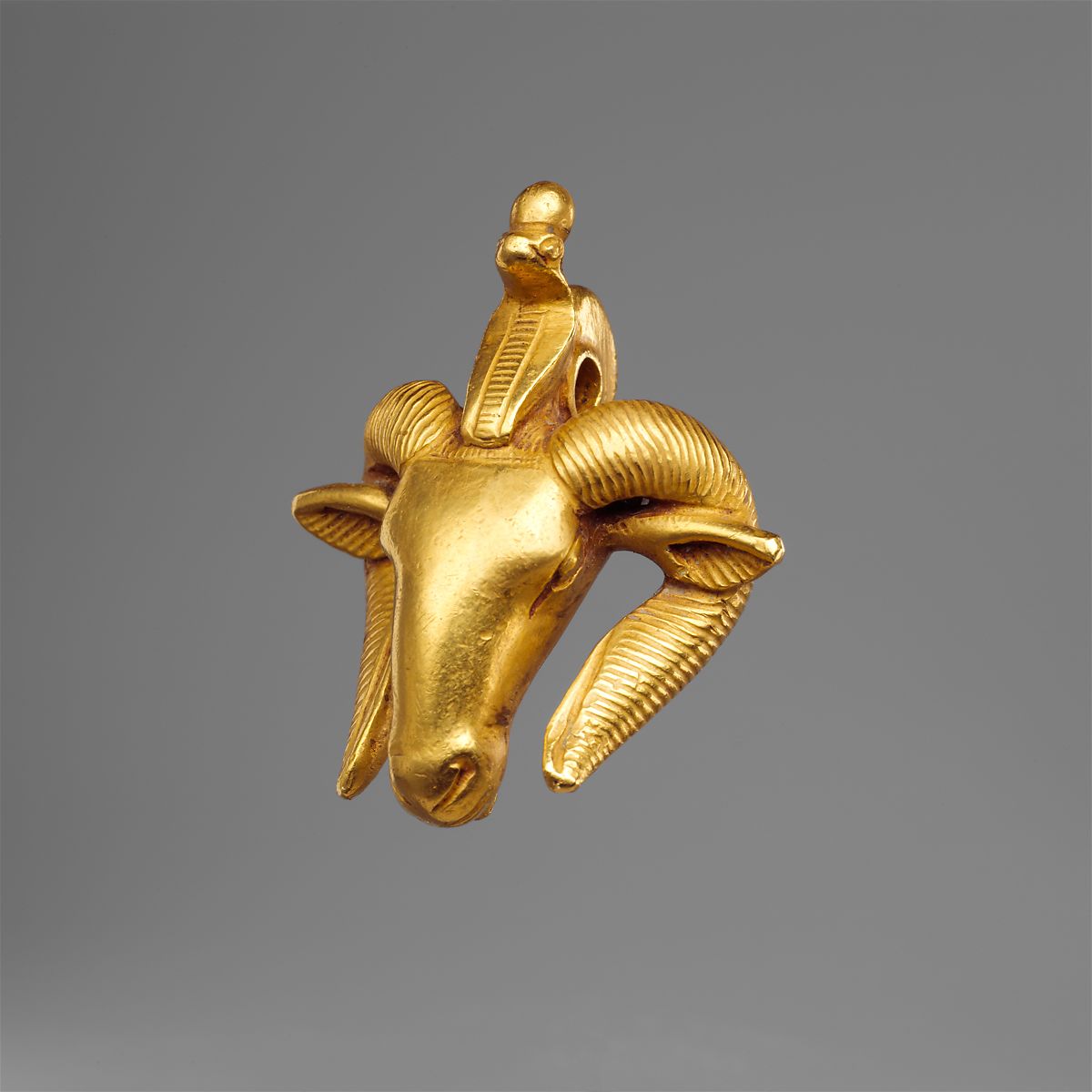
Ram's-head Amulet
The vast majority of the world’s gold is hoarded by individual savers (primarily gold coins) and governments (primarily gold bars) as a sort of nest egg or safe haven instrument.
You’ll recall in last month’s issue, I interviewed Van Simmons, partner and president of David Hall Rare Coins, who said:
You know, coins are sort of the supreme act of sovereignty sitting there saying, “We are our own free nation, making our own gold and silver coins.” The first gold coin struck in the United States was made in 1795… the 1795 Small Eagle $5 gold piece. That's one of the reasons I like them; there’s just so much history attached to them.
There’s almost 34,000 tonnes of gold in “official holdings” across the world with the United States maintaining the number one spot at over 8,000 tonnes.
Today, most of the gold that is newly-mined or recycled is used in the manufacture of jewelry – and nearly 98% of the gold that has ever been mined remains available for trade, barter, recycling, etc.
From an industrial standpoint, gold can be stretched incredibly thin and is an excellent conductor of electricity making it ideal for use in a variety of electrical devices — including mobile phones, televisions, GPS devices, laptops, and computers.
And because gold is an almost perfect reflector of infrared light – it has an array of advanced applications in the aerospace industry, including as a coating for astronauts’ helmet visors and as well for telescopes – including the James Webb Space Telescope – providing a near perfect view of the infrared invisible universe.


Gold Coating: A Near-Perfect Reflector of Infared Light
Gold is a Rare Element
For all its infinite beauty… gold is also very rare.
Each year, global mining adds just 2,500 to 3,000 tonnes of gold to the overall above-ground stockpile. For comparison, global silver production chimes in at about 25,000 tonnes and copper at about 18 million tonnes!
The best estimate for the total amount of gold that has been mined throughout history is 190,040 tonnes – with around two-thirds of that occurring after 1950.
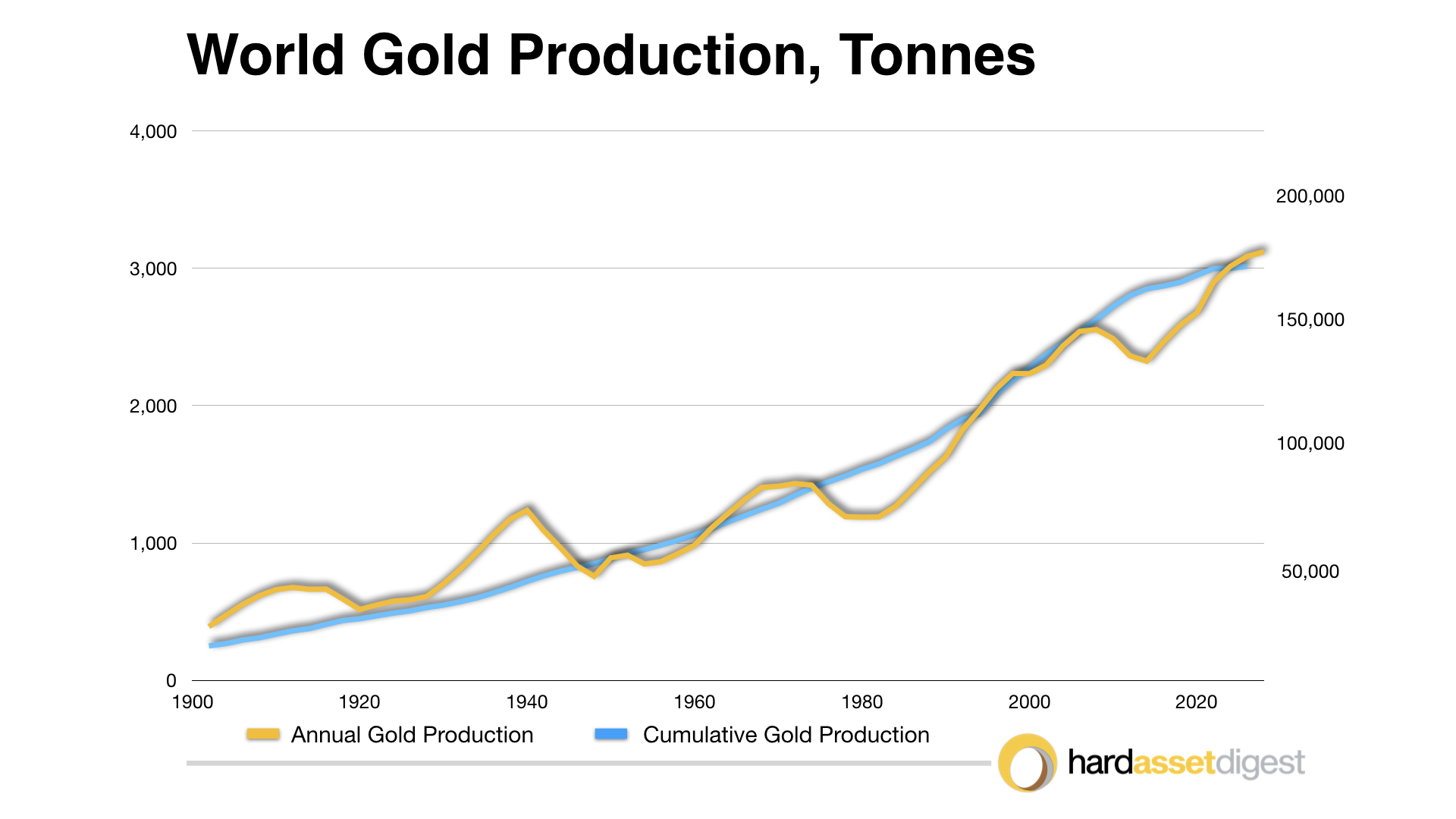
If we could somehow gather every scrap of gold that’s ever been mined, it would fit neatly inside a cube measuring just 21 metres on each side.

Or to picture it another way: Those 190,040 tonnes would fill only about a third of the Washington Monument!

Illustration: Total Mined Gold vs. Washington Monument
In geology, gold is concentrated one-thousand or more times from its usual crustal abundance of three parts per billion into economic mineral deposits by complex geological processes.
These include temperature and pressure changes and can be driven by structural and tectonic events, magmatic, volcanic, and hydrothermal processes, and/or surficial weathering.
Geologists, prospectors, and miners alike spend lifetimes scouring creek beds, banging outcroppings with a hammer, and drilling into the earth’s surface in pursuit of gold riches.
The world’s largest gold deposit is the Grasberg Gold/Copper Mine of Papua, Indonesia, with an estimated $40 billion in gold ore reserves. The mine is a joint venture between Freeport-McMoRan and Rio Tinto.

Grasberg Gold/Copper Mine
The largest gold nugget ever found – known as the Welcome Stranger and tipping the scales at 78 kg (175 lbs) – was discovered in Victoria, Australia, in 1869 by John Deason and Richard Oates (see below).
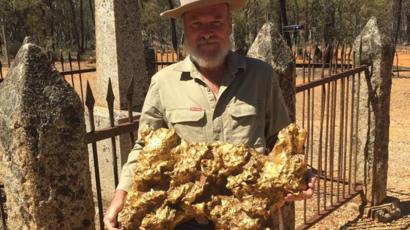
Welcome Stranger Nugget
And just last summer, in that same Australian state, a prospector found a gold nugget weighing 1.4 kg (pictured below). Naturally, he’s doing everything he can to keep his spot secret!
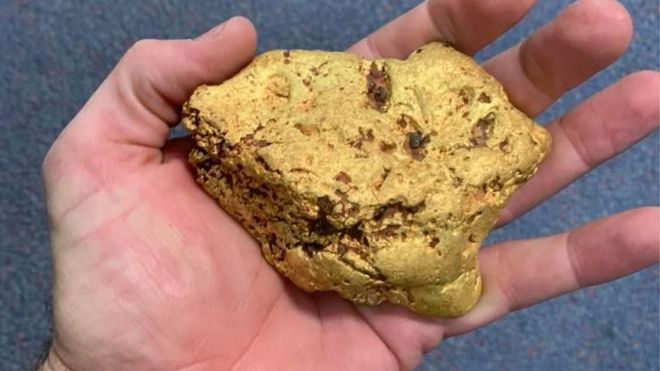
2019 Discovery: 1.4 kg Gold Nugget - Victoria, Australia
Gold will continue capturing the imagination of mankind for as long as we’re around!
So next time you’re thinking about gold as a speculation or through the lens of a precious metals exploration company… take a moment to reflect on gold’s incredible journey from outer space to our home planet.
There’s TONS more gold yet to be found… and there’s nothing more exciting than discovering earth’s most cherished metal.
I guess that’s why they call it gold fever!
Yours In Profits,
Mike Fagan, editor
Hard Asset Digest
Exclusive Interview with
Mickey Fulp – Mercenary Geologist
Mike Fagan: Mickey, it’s been a while since we last spoke… I’m excited to get caught up on what you’ve been doing and what you think of this market.
For my members who may not know a lot about you, why don’t we start with your background as a professional field geologist… and also how your publication – Mercenary Geologist – came to fruition?
Mickey Fulp: Sure, Mike… and great to catch up with you as well. So as you know, I have about 30 years as a practicing economic geologist, and I will emphasize the word economic because that's what makes ore deposits and also makes people money.
Thirty years of wide-ranging geological experience in the field — mainly in the Americas. I speak Spanish, so a significant amount of time in Latin America. I've also worked extensively in Europe and a fair amount in Asia.
About 12 years ago… as my ability to hump the hills started to go into decline… I put the word out to some of the people I know – including your father [Brian Fagan], Al Korelin, and others – that I wanted to be an analyst.
And within a couple of months, I had my first analyst job.
I was retained by Jay Taylor [Gold, Energy & Tech Stocks] to review his portfolio and make some recommendations. After a couple of months of doing that, I realized I could make more money doing it on my own. And Jay realized… or his wife realized (laughs!)... that I was costing him a lot of money!
So I went out on my own, and within a year I launched the Mercenary Geologist newsletter. That was back in April of 2008… kind of at the beginning of the global economic crisis. I made the decision to do it then because I wanted to get in at the bottom and go for the ride up.
Mike Fagan: And up it certainly did go! Mickey, you’ve coined the term “Mercenary Geologist,” and you’ve also made it the name of your banner. So what’s the meaning behind the phrase?
Mickey Fulp: The basic definition of a mercenary – and it's commonly applied to soldiers, yet certainly not restricted to soldiers – is a professional for hire. So I've been a professional geologist for over 40 years now, and most geologists are for hire, well... because we really don’t have real jobs!

Mickey Fulp, the Mercenary Geologist
We go from contract to contract to consulting job to consulting job. And as a consulting geologist, you're essentially semi-retired your whole career. In 2007, when I became an analyst, I was at my first speaking appearance at the Chicago Resource Expo, and I was asked to introduce myself.
I said something along the lines of, "Good afternoon, I'm Mickey Fulp… I’m an analyst… and a mercenary geologist!"
The audience either laughed, chuckled, or smiled… and so that became my brand and the handle for the website.
Mike Fagan: That’s great… funny how someone will say something and it sort of sticks! Now, I also understand you spend quite a bit of time mentoring up-and-coming fellow mercenary geologists as your way of giving back to the scientific discipline that’s given you so much over the years. Can you tell my readers about that?
Mickey Fulp: I do. The business has given me a lot over the years, made me lots of money, so I feel obligated to give back. So what I do is I offer my services as a mentor for the Society of Economic Geologists.

I am very well connected with a couple of mining schools. I do periodic presentations. I'm always available to young geologists to give them career advice and to help them out as they're starting because, as you know, this is a boom and bust business.
You really need to make hay while the sun shines! You need to work as hard as you can during the booms knowing that – with the inevitable busts that come – you may not be busy all the time.
Mike Fagan: Very true. Mickey, you’ve always been a great story teller. I remember you telling me… I think it was over drinks following one of the Vancouver conferences… about the time one of your “mercenary” colleagues became incensed over comments by a non-field geo! Would you mind retelling that story for my audience?
Mickey Fulp: Yeah, I do remember that, Mike! This goes back to 2007 when I had just started doing some analyst work. But I was still pretty much a field geologist.
So yeah… this is at the bar.
And for people who attend the mining conferences in Toronto, specifically the PDAC, they'll know there's a bar at the Intercontinental Hotel, which is connected to the Convention Center there, and it was an afternoon following a conference… so the bar was absolutely packed.


I walk in, and I can’t find a seat anywhere... I finally see a colleague of mine, Jeff, waving me over… so I go and sit down with him and a couple of other industry guys. And we start talking about being field geologists… mercenary geologists, if you will.
And there’s this one guy sitting among us who’s kind of... how should I put this… an office GIS-geologist-draftsman-computer-nerd-techie-type. And he’s trying to give Jeff – whom I consider the Canadian version of a mercenary geologist if I've ever known one – some sort of “lesson in field geology.”
Bad idea!
So after a bit of heated back and forth — Jeff’s finally had enough! He stands up, slams his beer down, pounds his fist on the table, and, with his sharp western Canadian accent, bellows out...
"You're not a field geologist until you've had malaria, got thrown in jail in a third-world country, and had a fistfight with a driller in a foreign language!"
He says this SO LOUD that literally half the bar immediately goes quiet and then bursts into laughter. I'm laughing so hard I'm crying. One of our other mates is halfway rolling on the floor. So upon collecting my thoughts, I realize the profoundness of his statement. I kind of chew on my cheek, scratch my bald pate, and think for a second or two.
Suddenly, I erupt, slam my beer down, pound my fist onto the table, and… in my best gravelly Heartland of America voice, and I do have a very loud voice…
"You're not a field geologist until you've had cholera, traveled for 10 days under an assumed name, and escaped from a third-world country with a warrant for your arrest!"
This, of course, really brought down the bar!
Mike, to make a long story short… any geologist who’s truly paid their dues in the field will have these sorts of experiences. That's why we always go to the bar after work. We tell stories, talk about the day, exchange stock tips, and talk about what kind of core is coming out of the drill pipe.
We scribble notes, make maps, and draw cross sections on bar napkins.
Amazingy, that's how a lot of mineral discoveries are made!
Mike Fagan: Classic... thanks for sharing that story, Mickey! Jumping into perhaps your favorite topic – precious metals – would you say that we are in a new gold bull market… and is now a good time to be looking at the juniors?
Mickey Fulp: Well, I think we are arguably in an incipient bull market for gold. I think, as with most markets, we would hope it comes and goes in fits and starts… kind of two steps forward, one step back. And so far, we've had just that.
As we speak today, I’m looking at gold, and it’s at $1,500 an ounce. So it has tested resistance repeatedly at about $1,455 – and it keeps bouncing. So from that point of view, it all looks good going forward.

We have to remember, though, that this is a high season for gold, if you will. We pretty much expect gold to rise sometime from mid-December pretty steadily until the end of February every year.
My research team has analyzed the 50-year record of gold prices since a year before Nixon took America off of the gold standard, starting in 1970. We see this year after year... this seasonal rise in gold. From that point of view — yeah, it's a good time to be looking at gold juniors.
But it was actually a better time a few weeks ago at the bottom of tax loss selling.
You always want to buy when people are selling during tax loss season. You pick your favorite stocks that have gotten beaten down, you buy them, and you flip them after the beginning of the year... and you can make some pretty nice profits doing that.
Mike Fagan: Would you mind giving my readers one or two of your Top-Picks from the precious metals arena?
Mickey Fulp: Sure, I'll give you two of the companies I cover that are sponsors of my website. The first is Ely Gold Royalties (ELY.V). We picked ELY in February of 2018, so it's approaching two years now. We picked it at C$0.09 and it closed yesterday at C$0.44 per share.

That's almost a five-bagger, and it's a hybrid prospect generator / royalty company.
ELY is making the transition from a prospect generator to more of a royalty company. So we think it has a really strong upside. It's still mostly valued as a prospect generator, so it's not yet fully valued as with its peers in the junior royalty space.
Over the course of the last year it has added three production royalties. It likely has a couple more on the way in the near future. It’s cash flow positive. So I'm very bullish on Ely Gold Royalties.
The other company is Realgold Resources. It's a private company still – but it's soon to be public via a venture exchange shell.
Realgold is a Carlin-type gold play in the Kyrgyz Republic. It's a bit out of my bailiwick. At one point, I said I would never put my money in a “stan,” in a country that ends in “stan.” But it's no longer called Kyrgyzstan; it's called the Kyrgyz Republic — so I did not violate my rule of thumb there (laughs!).
So I encourage people to take a look at Realgold. I've posted a couple of things about it on my website, and, for accredited investors who are subscribers to my newsletter, there's a private placement opportunity in the company right now, pre-RTO, that they may want to take a look at.
I’m a two-time private placee in this company. Within the last year and a half, there's been a total of C$11 million spent privately on drilling multiple targets. They’ve put together something on the order of, if memory serves, 274,000 hectares in 16 properties in southwest Kyrgyz Republic.

The best drill result so far is 21 meters of 33.7 grams per tonne gold. To put that in context — that's over an ounce per ton!
Mike Fagan: That’s an impressive early intercept! Mickey, I know you’re a stalwart contrarian, and, by that very nature, you’re always seeking out those best-of-the-best companies in out-of-favor markets.
So which beaten down sectors do you have your eye on right now, and, more importantly — what are you buying?
Mickey Fulp: Well, you're right, Mike — I'm a contrarian. So our job is to find stocks that are unknown, unwanted, unloved, and undervalued at any particular time.
So what I'm doing right now is, as per usual, buying during tax loss season. I'm generally adding onto positions. And that would constitute averaging down.
(Editor’s Note: Tax loss season generally runs from November - December wherein investors actively seek to realize capital losses for the upcoming income tax season.)
Uranium is a beaten down sector, and it's been beaten down now for almost 10 years. It will come back at some point. So you might look at uranium.

In terms of uranium companies, I'm not buying any right now but I do have long-term uranium positions. I like the domestic US producers and developers.
One uranium company I’ll mention is Azarga Uranium (TSX: AZZ). I’m a founding shareholder of the private company that eventually merged with Azarga.
Azarga owns a couple of really attractive ISR (in-situ recovery) projects in central Wyoming. I’ve had a long-term relationship with the predecessors that owned those two properties; specifically Strathmore Minerals / Energy Fuels.

And then, more importantly, Azarga's flagship property is the Dewey Burdock Project in South Dakota. They recently filed a PEA [Preliminary Economic Assessment] on that property that's very robust.
Dewey Burdock is very high-grade ISR project; grades on the order of two to three times what usual production grades are. It's 0.12% uranium, plus or minus. And they recently received a favorable ruling from the Nuclear Regulatory Commission… so permitting is now proceeding.
We expect final permits to come in due course. And then, the entire sector waits for the Trump administration to do something with their Section 232 actions on national security issues for domestic uranium mining companies.
Certainly any uranium project, including ISR projects in the United States, require a much higher uranium price than the present $25/lb level to be economic. So, that’s something to watch for as a contrarian.
Mike Fagan: Turning to base metals such as copper, nickel, and zinc… we’ve seen a bit of upward momentum there of late. What’s your outlook for the base metals – and any particular companies you’re excited about?
Mickey Fulp: I think the outlook on base metals is completely tied to the trade tariff talks between China and the United States along with President Trump's ability to get, first and foremost, phase-one signed and then some real progress made in a phase-two agreement.
I think until that happens, the base metals are going to be in limbo.
Nevertheless, we have seen a stronger copper price of late. Today, it’s at $2.81 per pound — a 7-month high. I think that move is based on the idea that an initial trade agreement will happen shortly after the first of the year.
(Editor’s Note: Phase-one was indeed signed on January 15, 2020.)

The supply/demand fundamentals of copper are absolutely compelling in the mid to long-term. The short-term certainly depends on a successful resolution of the trade talks.
If that happens, the base metals market, led by copper – base metals are always led by copper by the way – is going to soar, in my opinion. And, if a resolution does indeed happen, I'd put a 2020 target-price on copper of $3.30 per pound. We'll see what progress is made.
I do cover one copper company, and that's Trilogy Metals (NYSE: TMA)(TSX: TMQ). Trilogy is a NY American-listed company with two of the best undeveloped, high-grade, giant copper deposits in the world. And this is in northwest Alaska — one of the safest geopolitical jurisdictions on the planet.

Trilogy Metals TMQ Chart
South32 – the giant Australian Perth-based base metal, aluminum, coal producing company – recently signed a 50/50 joint venture with Trilogy for $145 million.
Trilogy also has an anticipated catalyst coming in the new year, and that would be the approval of their EIS [Environmental Impact Statement]. So permitting is proceeding for the road that needs to be built to get to these projects — about a 210-mile road from the Dalton Highway north of Fairbanks into northwest Alaska.
We picked Trilogy in May of 2017 at US$0.65 per share. It closed recently at US$2.30 a share. It's been as high as $3.14. So there's certainly some upside going forward for Trilogy Metals.
Mike Fagan: Mickey, as we discussed, you’ve set up Mercenary Geologist as a free web-based publication, and you do quite a lot on Twitter as well. I’m curious about the evaluation process in terms of the stocks you cover, and would you mind also just touching upon the importance of management, especially as it relates to the juniors?
Mickey Fulp: Sure, Mike. To initiate coverage, I need to be a significant shareholder of the company so I've got skin in the game — and I put my mercenary money where my big mouth is!
I use four criteria. Since I'm a geologist, it starts with the project. It needs to pass technical muster, and it needs to be in a safe geopolitical jurisdiction. Or, it has to be so geologically compelling – as is the case for Realgold in the Kyrgyz Republic – that I'll take on some additional geopolitical risk.
Secondly, share structure needs to be tight. I want management to have skin in the game as well, so that they operate in the best interest of all shareholders.
Then management; I want them to be of technical background. I want the CEO to have a degree in mining engineering or geology. I want that manager to have had previous success and experience in the business as a CEO.
I always say... if you've bankrupted three companies, or you’ve rolled back the company’s shares, or you've gone on to another company without success — then, in my opinion, you're no longer an entrepreneur or a venture capitalist… and that's what's required in this business. So management is of utmost important.
And finally… you need cash on-hand or the ability to raise funds for exploration without undue dilution. Dilution is the bane of most juniors.
Mike Fagan: And speaking of cash from an individual investor standpoint, what’s your take on capital preservation… especially for investors venturing into the highly volatile junior sector? In other words, what’s the proper mindset for knowing when to average down, protect profits, etc.?
Mickey Fulp: Well, first and foremost, a proper mindset should be that investing in the junior space is gambling where you can skew the odds in your favor. I'll use an analogy. If you go to a casino and you want to lose money — you play roulette. If you're a good card player, you play blackjack or poker because you have the ability to skew the odds in your favor.
That's what we try to do as resource stock speculators with our discretionary income in the high-risk junior sector. At Mercenary Geologist, we have a trading philosophy called The Power of Two. I've been using this since I first “speculated,” and I refuse to call it “investment.”
These are pure speculations.
Since 1992, when I first got involved in the resource sector, my broker at Haywood Securities – who is a very good friend of mine – taught me this idea that when stocks double, you sell half, thereby taking all of your initial investment money off the table.
You preserve your capital by doing that. And then, you still have half of your position to play to the upside.
So we encourage our subscribers to do that. We call it The Power of Two because if you do it once, you've preserved your capital. If you do it twice – meaning you’ve sold half at a double; reinvested those proceeds into a second company that doubles; sell half again – then you've preserved your capital AND you've increased your equity position by a factor of two because you now have two companies you're playing for the upside with a zero cost basis.
Do it three times, and you've got three times the value on paper… and so on and so on. In terms of capital preservation, that’s what you aim for: trading as regularly as possible at a zero cost basis.
Averaging down... that's an entirely different ball game, and it has lots of ins and outs and potential pitfalls. But if you really like a company and it's been beaten up, a good time to average down is during tax loss season when everyone is selling.
We run a completely contrarian business model, so when most people are selling — we're usually buying!
Mike Fagan: Mickey, I’d like to pick your brain for a moment, if you will. You know, as investors and speculators, we typically look at things through a relatively short time-lens of say a few months to a few years. But I often find myself pondering what the world is going to look like for our grandchildren and our grandchildren’s grandchildren.
Do you find yourself doing the same thing… I mean, in a world of finite natural resources, what sort of keeps you up at night if anything?
Mickey Fulp: Well, I probably should say... nothing really keeps me up at night. I'm very dedicated to this business. So generally... I go to bed at night and one of the best things… maybe the only good thing… about getting old is you don't have to sleep so much (laughs!).
I find myself looking at the clock at night and going… Okay, how many hours of sleep do I need before I get to get up and go to work again in the morning?!
I truly love what I do!
Yet, as a capitalist and libertarian, I am particularly concerned with the way certain parts of the world – especially the developed world – are going with a turn toward socialism and what I view as fascism; socialism and its conjoined twin, fascism.
I'm concerned with the Chinese and social credit scores and surveillance.
By that same token, I'm very concerned with – and I’ve been working very diligently on solutions for – America's dependence on unsavory, unfriendly, and unstable foreign governments, specifically China, Russia, and South Africa, for significant parts of our mineral supply.
I will disagree with you, Mike, that we live in a world of finite natural resources. In my opinion, we live in a world of infinite natural resources.
To my knowledge, the world has only run out of one commodity in its history — that being bird guano. I wrote at length about that at one time. I believe we have the ability to find what we need when we need it or find substitutes for it.
From 1840 to 1875, the British mined most of the world's bird guano in the desert islands of Peru and northern Chile. And we didn't have bird guano resources anymore. So what did the explorers do? Well, we found nitrate deposits in northern Chile in the Atacama Desert, which became a substitute for bird guano for fertilizer and as a source of nitrogen, specifically.
Then during World War I, the Germans invented a way to fix atmospheric nitrogen to make ammonia. So we've got plenty of nitrogen fertilizer – in fact, an infinite resource – considering that nitrogen comprises 79% of the atmosphere. You can go on and on.
History will show that when we need something, we find it, we develop it, or we find a substitute. Oftentimes, we mine lower and lower grades but our technology becomes better and better. So the least thing I'm worried about is running out of any natural resources on earth.
I'll add to that by saying there are two schools of thought here. One, there are the Malthusians, based on the ideas of John Malthus in and around 1800, who predicted that, with the world's population growth, we'd quickly run out of food. Well, that hasn't happened.
And then there are the cornucopians, and I am in the latter category. We subscribe to the idea that we'll find what we need when we need it. In the history of mankind, we've always done that.
Now, that does not preclude that we couldn't have natural resource wars going forward if America does not wean itself from governments that are unfriendly to us for some very critical mineral resources.
Mike Fagan: Excellent take, Mickey. It’s been a fascinating discussion as always. Just to make sure my readers know exactly how to follow you, can you quickly go over your website, Twitter handle, etc.?
Mickey Fulp: Absolutely, Mike. It’s been a pleasure for me as well. The website is www.MercenaryGeologist.com.
As I mentioned, we run a sponsor model, so it’s a 100% free subscription upon signup… and that includes my stock recommendations — but you have to subscribe to get those. That's the carrot we dangle to get people to sign up.
We have over 6,900 subscribers as we speak.
If any of your readers would like to subscribe… and I hope they will… they can go to the website and, on the left side is my mugshot, and below that is the banner they’ll click to go to the signup page.
They can give us their name and email address… or even a fake name… we don't care! But they must give us a working email address.
Upon signup, they’ll have immediate access to my exclusive stock picks. They’ll also receive a notice every Sunday about my content.
By the end of the year, we'll have somewhere around 190 pieces of content posted on the website, so that's a little less than four per week — so pretty active.
The Twitter handle is @mercenarygeo 
We have 51,700 Twitter followers at this juncture where we're quite active on a potpourri of things that are of interest to me and hopefully of interest to my Twitter followers.
Mike Fagan: Mickey, thank you once again... I’ll look forward to catching up with you again in the new year!
Mickey Fulp: Same to you, Mike. Here’s to a very fruitful new year and new decade!
